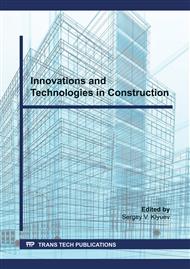[1]
V.A. Kochetov, Roman concrete (1991).
Google Scholar
[2]
S.-A.Yu. Murtazaev, M. Sh. Salamanova, M.S. Saidumov, Z.Kh. Ismailova, Influence of active surface centers on the reactivity of mineral additives, Modern Science and Innovations (2017). 2(18). Pp. 168-175.
Google Scholar
[3]
S.-A.Yu. Murtazaev, M. Sh. Salamanova, Prospects for the use of thermally activated raw materials of aluminosilicate nature, Privolzhsky scientific journal (2018). 46. Pp. 65–70.
Google Scholar
[4]
S.-A. Yu. Murtazaev, M.Sh. Salamanova, A. Alaskhanov, Z. Ismailova, Features of Production of Fine Concretes Based on Clinkerless Binders of Alkaline Mixing, 14th International Congress for Applied Mineralogy (ICAM 2019). Pp. 385-388.
DOI: 10.1007/978-3-030-22974-0_93
Google Scholar
[5]
R. Fediuk, Reducing permeability of fiber concrete using composite binders, Special Topics and Reviews in Porous Media (2018). 9(1). pp. v-vi.
DOI: 10.1615/specialtopicsrevporousmedia.v9.i1.100
Google Scholar
[6]
N.R. Rakhimova, State and perspective directions of development of research and production of composite slag-alkaline binders, solutions and concretes, Building materials (2008). 9. Pp.77-80.
Google Scholar
[7]
D. Hardjito, S. Wallah, D. Sumajouw, B. Rangan, On the development of fly ash-based geopolymer concrete, ACI Materials Journal (2004). 101(6). Pp. 467-472.
DOI: 10.1007/s10853-006-0523-8
Google Scholar
[8]
R. Fediuk, A. Pak, D. Kuzmin, Fine-Grained Concrete of Composite Binder. IOP Conference Series: Materials Science and Engineering. (2017). 262(1). 012025. https://doi.org/10.1088/1757-899X/262/1/012025.
DOI: 10.1088/1757-899x/262/1/012025
Google Scholar
[9]
G.S. Rostovskaya, I.P. Chernobaev, Raw material base of slag-alkali cements, Cement (1985). 11. P.20.
Google Scholar
[10]
P.V. Krivenko Operational properties of concrete on slag-alkali cement, Building materials and structures (1980). 4. Pp.23.
Google Scholar
[11]
R. Fediuk, A. Smoliakov, N. Stoyushko, Increase in composite binder activity. IOP Conference Series: Materials Science and Engineering (2016). 156(1). 012042.
DOI: 10.1088/1757-899x/156/1/012042
Google Scholar
[12]
J. Davidovitz, Geopolymer. Chemistry and applications (2008).
Google Scholar
[13]
J. Davidovits, Geopolymer Chemistiy and Properties, Proceed. 1st Europ.Conf. on Soft Mineralurgy Geopolymer 88,, France (1988). pp.25-48.
Google Scholar
[14]
R.S. Fediuk, A.K. Smoliakov, R.A. Timokhin, V.O. Batarshin, Y.G. Yevdokimova, Using thermal power plants waste for building materials. IOP Conference Series: Earth and Environmental Science (2018). 87(9). 092010.
DOI: 10.1088/1755-1315/87/9/092010
Google Scholar
[15]
A. Garcia-Luna, H. Minard, C. Prieto-Gomez, C. Soare, M. Viviani, Microsilextm a new material to improve environmental performance of cement and concrete, Proceed. 3rd International Symposium Non-traditional cement & concrete, (2018). Pp. 237-244.
Google Scholar
[16]
R.S. Fediuk, V.S. Lesovik, A.P. Svintsov, N.A. Gladkova, R.A. Timokhin et al, Self-compacting concrete using pretreatmented rice husk ash, Magazine of Civil Engineering (2018). 79(3). Pp. 66-76.
Google Scholar
[17]
V.D. Glukhovsky, I.A. Pashkov, B.C. Grigoriev, Complex use of blast-furnace and electrothermophosphoric slags in the production of high-strength cements and concretes, News of universities: Building and architecture (1980). 5. Pp. 62-66.
Google Scholar
[18]
S.-A.Yu. Murtazaev, M.Sh. Salamanova, M.Sh. Mintsaev, R.G. Bisultanov, Fine-Grained Concretes with Clinker-Free Binders on an Alkali Gauging (Fine-grained concrete based on alkaline activated binders), Proceedings of the International Symposium Engineering and Earth Sciences: Applied and Fundamental Research, (ISEES 2019).1. Pp. 500-503.
DOI: 10.2991/isees-19.2019.98
Google Scholar
[19]
D.K-S. Bataev, S.-A. Yu. Murtazaev, M.Sh. Salamanova, S.S. Viskhanov, Utilization of Cement Kiln Dust in Production of Alkali-Activated Clinker-Free Binders, Proceedings of the International Symposium Engineering and Earth Sciences: Applied and Fundamental Research, (ISEES 2019).1. - Pp. 457-460.
DOI: 10.2991/isees-19.2019.89
Google Scholar
[20]
T. Abirami, M. Loganaganandan, G. Murali, R. Fediuk, R. Vickhram Sreekrishna, T. Vignesh, G. Januppriya, K. Karthikeyan, Experimental research on impact response of novel steel fibrous concretes under falling mass impact. Construction and Building Materials (2019). 222. Pp. 447-457. https://doi.org/10.1016/j.conbuildmat.2019.06.175.
DOI: 10.1016/j.conbuildmat.2019.06.175
Google Scholar
[21]
M. Mage, Efficiency Fuetors for Condensed Silica Fume in Concrete Proceedings of Canwet, ACI Third International Conference. Fly ash, silica fume, sludge and Natural Pozzolans in concrete (Trondheim) (1989). 2. Pp.783-798.
DOI: 10.14359/2385
Google Scholar
[22]
R. Fediuk, A. Smoliakov, A. Muraviov, Mechanical properties of fiber-reinforced concrete using composite binders. Advances in Materials Science and Engineering (2017). 2316347.
DOI: 10.1155/2017/2316347
Google Scholar


